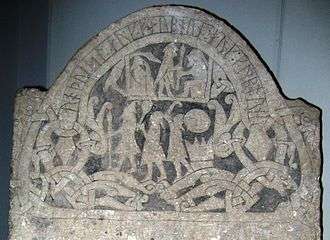Gotland Runic Inscription 181

This Viking Age runestone, designated as G 181 in the Rundata catalog, was originally located at a church at Sanda, Gotland, Sweden, and is believed to depict the three Norse pagan gods Odin, Thor, and Freyr.
Description
The runestone was discovered in the churchyard of Sanda church in 1863[1] and is currently located in the Swedish Museum of National Antiquities. It is classified as being carved in runestone style Pr2, which is also known as Ringerike style.
The inscription depicts two scenes under an arching runic text band. The lower panel has three figures who hold a spear, a hammer or club, and a sickle. Because the weapon of Odin was the spear Gungnir, that of Thor the hammer Mjöllnir, and because Freyr is identified with farming, the figures have been identified as these three gods.[2] The figures are depicted as wearing typical Viking Age clothing, including a cloak known as a hekla and a tasseled conical cap called a skott-húfa.[3] The upper scene also has three figures, which are considered to be the same gods. A large bird that may be a crane or goose is shown bending its head over Freyr.[4] The meaning of the bird depicted in this manner is not understood.
Some authorities have cited the runestone as evidence that Odin, Thor, and Freyr formed a devine Norse triad or trinity.[4] The proposition of this devine triad comes from theories of comparative religion and descriptions and depictions of these gods.[5] Other evidence for such a triad includes Adam of Bremen's description of the Temple at Uppsala as having three statutes of these gods.[6] These three are also the only Norse gods known to have been actively worshipped during the Viking Age.[7]
The runic inscription is carved in the younger futhark and consists of three personal names. The name Gunnbjôrn translates as meaning "Battle Bear"[8] and Farbjôrn may mean "Far Traveling Bear."
Inscription
Transliteration of the runes into Latin characters
- : roþuisl : aug : farborn : auk : kunborn :[9]
Transcription into Old Norse
- Hróðvísl ok Farbjôrn ok Gunnbjôrn.[9]
Translation in English
- Hróðvisl and Farbjôrn and Gunnbjôrn.[9]
References
- ↑ Jungner, Hugo (1930). "Den Gotländska Runbildstenen från Sanda: Om Valhallstro och Hednisk Begravningsritual" (PDF). Fornvännen. Swedish National Heritage Board. 25: 65–82. ISSN 1404-9430. Retrieved 4 December 2011.
- ↑ "Art and Architecture (Tuetonic)". Encyclopedia of Religion and Ethics. 1. Elibron Classics. 2005. p. 887. ISBN 1-4212-9732-9.
- ↑ Ewing, Thor (2006). Viking Clothing. Tempus. pp. 110, 117–118. ISBN 0-7524-3587-6.
- 1 2 March, H. Colley (1898). "Mythology of Wise Birds". The Journal of the Anthropological Institute of Great Britain and Ireland. 27. London. p. 231.
- ↑ Dumézil, Georges (1973). Gods of the Ancient Northmen. Haugen, Einar (trans.). University of California Press. pp. 17–25. ISBN 0-520-02044-8.
- ↑ Adam of Bremen, Gesta Hammaburgensis ecclesiae pontificum 26.
- ↑ Davidson, Hilda Ellis (1993). The Lost Beliefs of Northern Europe. Routledge. p. 106. ISBN 0-203-40850-0.
- ↑ Green, Dennis Howard (1998). Language and History in the Early Germanic World. Cambridge University Press. p. 81. ISBN 0-521-47134-6.
- 1 2 3 Project Samnordisk Runtextdatabas Svensk - Rundata entry for G 181.